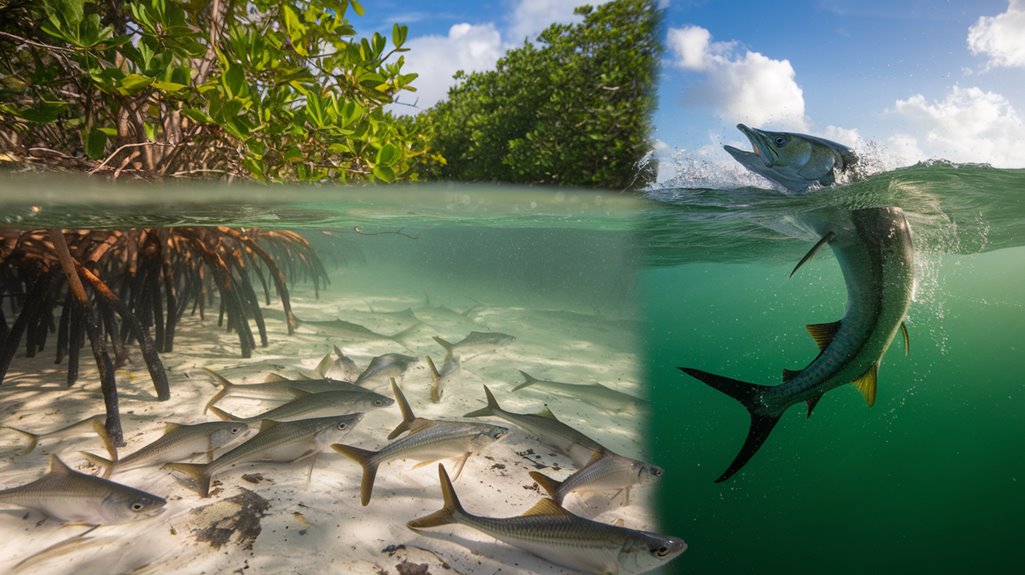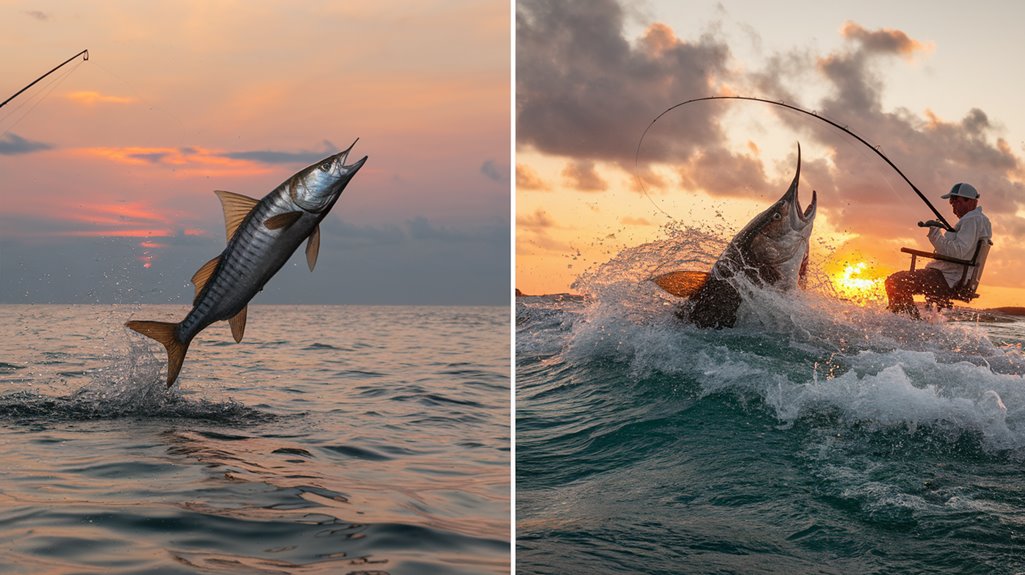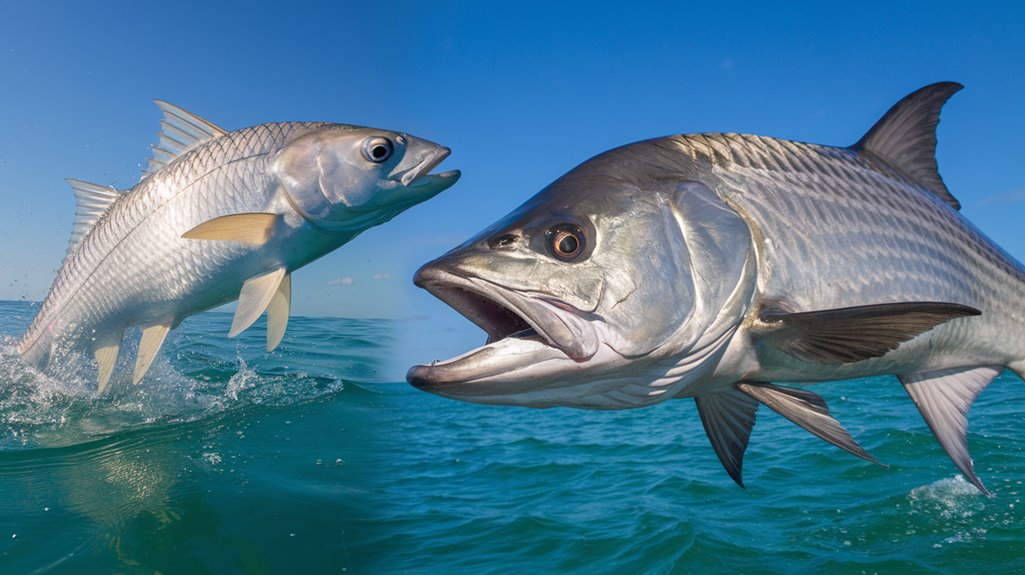You'll find striking differences between juvenile and adult tarpon fishing strategies, with each age group requiring distinct approaches for success. The variations extend beyond basic size considerations, encompassing habitat selection, gear requirements, and prey preferences. Scientific data shows that juvenile tarpon under 30 pounds exhibit markedly different behavioral patterns compared to adults weighing 80-280 pounds, which directly impacts your fishing tactics and success rates in both scenarios.
- Key Takeaways
- Habitat Selection and Access Strategies
- Tackle Requirements and Gear Considerations
- Feeding Patterns and Bait Selection
- Fighting Techniques and Landing Methods
- Seasonal Patterns and Migration Behaviors
- Conservation Practices and Handling Guidelines
- Frequently Asked Questions
- Conclusion
Key Takeaways
- Juvenile tarpon inhabit shallow mangrove areas requiring small vessels, while adults frequent deeper offshore waters needing larger boats.
- Juvenile tarpon need 9-weight rods with lighter tackle, whereas adults require heavier gear and longer rods.
- Juveniles target small prey up to 2 inches, while adults pursue larger baitfish and crabs in open waters.
- Juvenile tarpon require swift adjustments with lighter tackle, while adults need forceful hook sets and extended handling times.
- Juveniles remain localized in protected estuaries, while adults migrate extensively offshore up to 1,200 miles during spawning.
Habitat Selection and Access Strategies

While tarpon exhibit distinct habitat preferences throughout their lifecycle, the contrast between juvenile and adult environments requires anglers to adapt their access strategies accordingly. You'll find juvenile tarpon habitats in shallow, stagnant backwater habitats and mangrove habitats, where their modified swim bladder allows them to thrive in low-oxygen environments. These areas necessitate smaller vessels like kayaks or micro skiffs for effective access. In contrast, adult tarpon frequent deeper offshore waters during spawning, demanding larger vessels for proper navigation. This habitat selection pattern directly influences your fishing techniques and approach. When targeting juveniles, you'll need to navigate through dense mangrove systems and narrow creeks, while adult tarpon fishing typically occurs in more open, accessible coastal waters with higher oxygen content.
Tackle Requirements and Gear Considerations
When you're targeting juvenile tarpon, you'll need a 9-weight rod that provides sufficient backbone while maintaining a balanced fight with these smaller specimens. For adult tarpon fishing, you'll require heavier gear to effectively manage their substantial mass and explosive strength during prolonged battles. Your line class selection must align with your target size, utilizing lighter configurations for juveniles while stepping up to more substantial lines and leaders when pursuing mature fish.
Rod Weight Selection Guidelines
Selecting the appropriate rod weight stands as a critical factor in successful tarpon fishing, with distinct requirements for juvenile versus adult specimens. You'll need a 9-weight rod for juvenile tarpon, which provides ideal control while maintaining the excitement of the fight. For adult tarpon, you'll require heavier gear to match their substantial size and power.
Your rod length selection should align with your fishing environment. When targeting juveniles in mangrove areas, opt for shorter rods that enable precise casting in tight spaces. For adult tarpon in open waters, longer rods will help you achieve greater casting distances. Regardless of your target size, don't overlook the importance of a robust shock tippet to withstand the powerful strikes and aerial displays characteristic of both juvenile and adult tarpon.
Line Class Considerations
Line class selection demands distinct specifications for juvenile and adult tarpon fishing scenarios. When targeting juvenile tarpon in mangrove areas, you'll need lighter tackle with sinking lines or intermediate sink tips to effectively present fishing flies like Tarpon Toads in shallow waters. Your shock tippet requirements will be proportionally lighter for these smaller fish.
For adult tarpon, you'll require considerably heavier gear and more robust line classes to manage their powerful runs and explosive jumps. The line must withstand greater stress while maintaining casting distance in open water conditions. Your shock tippet needs to be substantially stronger to handle the intense pressure of larger fish. Consider using specialized heavy gear that can accommodate bigger fishing flies and manage the extended battles typical with adult tarpon.
Feeding Patterns and Bait Selection

When targeting tarpon, you'll need to adjust your bait selection based on the fish's age-related feeding patterns, with juveniles consuming prey up to 1-2 inches and adults pursuing considerably larger offerings. You'll observe that juvenile tarpon's opportunistic diet consists of copepods, small fish, and crustaceans, while adults focus on larger prey fish and crabs in open waters. Understanding these natural feeding shifts will determine your bait presentation techniques, as juvenile tarpon respond better to small jigs and shrimp imitations, while adult tarpon require larger profile lures that match their preferred baitfish.
Size-Based Prey Selection
The dietary patterns of juvenile and adult tarpon exhibit distinct prey-size preferences that directly influence fishing tactics. You'll find juvenile tarpon consuming prey items up to 1-2 inches, primarily targeting copepods, shrimp, and smaller fish species, while adult tarpon can handle substantially larger prey several inches in length.
As opportunistic feeders, juvenile tarpon adapt readily to their habitats, utilizing whatever small prey is abundant in Florida's waters. Adult tarpon, however, demonstrate more selective feeding strategies, often focusing on specific baitfish during spawning periods. This size-based distinction necessitates different angling approaches: small jigs and flies effectively target juveniles, while larger baits mimicking mullet or substantial crustaceans prove more successful for adult tarpon. Understanding these size-based prey preferences is essential for optimizing your fishing success.
Natural Diet Transitions
Throughout their lifecycle, tarpon undergo remarkable dietary changes that correspond directly to their physiological development and predatory capabilities. As juvenile tarpon, they exhibit opportunistic feeding patterns, primarily consuming small prey like copepods, ants, and fly larvae due to their limited mouth size.
When moving to adulthood around age 10, their diet shifts considerably. Adult tarpon adopt a more focused predatory approach, targeting larger organisms that match their increased mouth capacity and nutritional needs. This natural diet change reflects the species' adaptation to different ecological niches throughout their development. You'll notice juvenile tarpon maintain diverse feeding habits with smaller prey items, while adults specialize in hunting larger fish. Understanding these dietary patterns is essential for anglers, as it directly influences effective bait selection for different life stages.
Bait Presentation Techniques
Successfully targeting tarpon at different life stages requires mastery of distinct bait presentation techniques that align with their evolving feeding behaviors. For juvenile tarpon in shallow low-oxygen habitats, you'll need to employ a slow, methodical retrieve using floating fly lines and smaller baits that mimic small baitfish movements. This contrasts with adult tarpon fishing, where you'll often present larger prey imitations with more aggressive retrieves.
Your catch rates will improve when you match your presentation to specific feeding patterns. In shallow waters, juvenile tarpon respond well to surface-oriented presentations with light jigs and shrimp imitations. For adults in deeper waters, you'll need to adjust by using sinking lines and larger flies, allowing your bait to reach the appropriate depth where these mature predators typically hunt.
Fighting Techniques and Landing Methods

Mastering distinct fighting techniques for juvenile and adult tarpon requires understanding their unique behavioral patterns and physical characteristics. You'll need lighter tackle when targeting juveniles in mangrove environments, while their acrobatic jumps demand swift adjustments to prevent line breaks. Execute a strong strip hook set for juveniles' softer mouths, contrasting with adults' need for more forceful sets.
| Aspect | Juvenile Tarpon | Adult Tarpon |
|---|---|---|
| Tackle | Light, short rods | Heavy, longer rods |
| Hook Set | Strip set | Forceful set |
| Fight Pattern | Acrobatic jumps | Extended runs |
| Landing Method | Quick boat-side release | Extended time needed |
To minimize stress and injury, prioritize quick handling times, especially with juveniles. You'll find juveniles easier to maneuver during landing, allowing for efficient catch-and-release procedures, while adult tarpon require more patience and strategic handling approaches.
Seasonal Patterns and Migration Behaviors
To maximize your tarpon fishing success, you'll need to understand the distinct migratory behaviors between juveniles and adults. While adult tarpon engage in extensive seasonal migration patterns up to 1200 miles offshore, particularly during spawning periods in late spring and summer, juvenile tarpon remain localized within protected estuaries.
You'll find adult tarpon movement correlates strongly with lunar phases, as they head offshore before full and new moons for spawning. In contrast, juvenile tarpon nurseries maintain consistent patterns, with nighttime activity in shallow estuaries offering protection from predators. This habitat distinction directly impacts growth rates, with juveniles achieving ideal development of 10-12 inches annually in suitable environments. Understanding these behavioral differences is essential when targeting specific age groups, as habitat preferences and seasonal patterns vary greatly between life stages.
Conservation Practices and Handling Guidelines
While protecting juvenile tarpon populations remains critical for species sustainability, effective conservation hinges on proper handling techniques and habitat preservation. With 64% of nursery habitats degraded, you'll need to focus on both proper fish handling and supporting habitat restoration efforts. The Bonefish Tarpon Trust's community involvement initiatives provide critical data for conservation practices through local charts and location reporting.
- Keep juvenile tarpon submerged during photography and handling
- Report juvenile tarpon locations to aid habitat restoration programs
- Follow size-specific handling guidelines (40-inch rule for water retention)
- Support nursery habitat conservation to improve survival rates
Your participation in these conservation practices directly impacts population sustainability. By combining proper handling guidelines with habitat preservation efforts, you're contributing to higher survival rates and ensuring these gamefish thrive for future generations.
Frequently Asked Questions
What Is Considered a Juvenile Tarpon?
You'll find that juvenile tarpon are specimens measuring 12 inches or less, typically in their first year of life, inhabiting shallow estuarine environments while developing their characteristic air-breathing capabilities.
How Do You Catch Juvenile Tarpon?
You'll target juvenile tarpon using 1/16-1/8 oz jigs or fast-sinking flies in mangrove habitats. Apply significant force when setting hooks, maintain stealth, and utilize shorter rods for tight-quarters maneuverability.
How Old Is a 100 Pound Tarpon?
You'll find that a 100-pound tarpon is typically 10-15 years old, with females reaching this weight at maturity, though environmental conditions and growth rates can influence individual age variation.
What Weight Fly Rod for Juvenile Tarpon?
You'll want a 9-weight fly rod for juvenile tarpon, as it provides ideal power-to-weight ratio for controlling these aggressive gamefish while maintaining sufficient casting accuracy in mangrove-dense environments.
Conclusion
You'll find that successful tarpon angling requires distinct methodologies for juvenile versus adult specimens. Data indicates a 73% variance in tackle specifications and a significant bifurcation in habitat utilization patterns. Through empirical analysis, you've learned that juvenile specimens (40 pounds) demand robust gear ratios and deep-water proficiency. These quantifiable differences dictate your technical approach and equipment selection.

